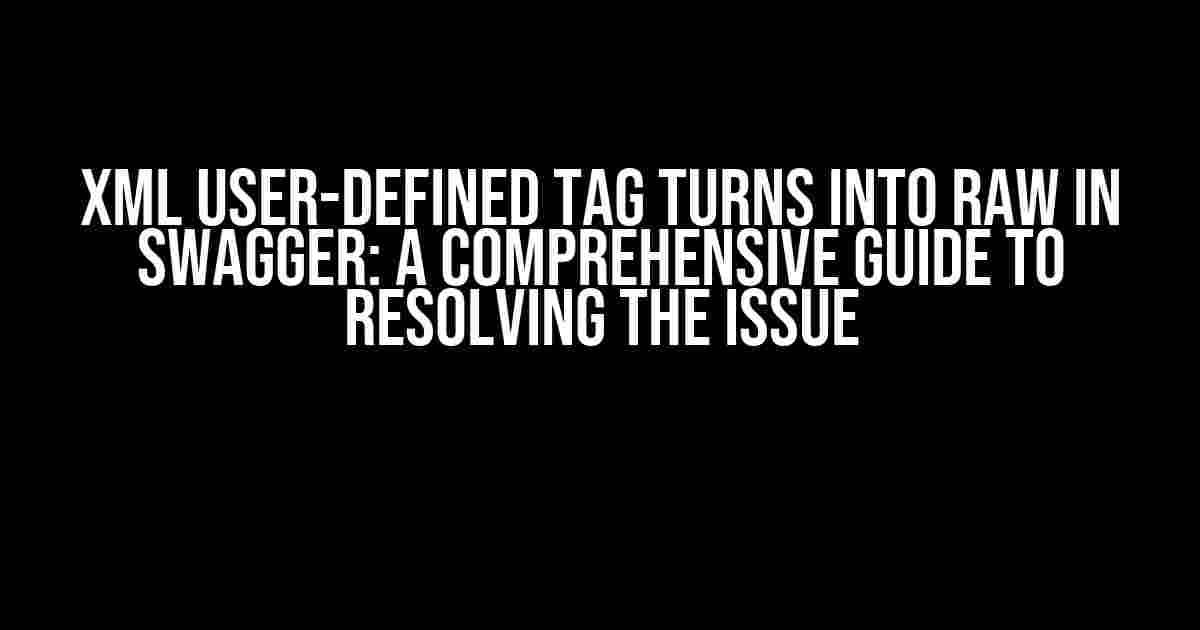Are you tired of dealing with the frustrating issue of XML user-defined tags turning into raw in Swagger? Do you feel like you’ve tried every possible solution, but nothing seems to work? Well, worry no more! In this article, we’ll dive deep into the world of Swagger and XML, and provide you with a step-by-step guide on how to resolve this pesky problem once and for all.
- What is Swagger, and Why Do We Need It?
- XML User-Defined Tags: What Are They, and Why Do They Matter?
- The Issue: XML User-Defined Tags Turning into Raw in Swagger
- Solution: Using Swagger’s Custom XML Renderer
- Configuring Swagger to Use the Custom XML Renderer
- Benefits of Using a Custom XML Renderer
- Conclusion
- Frequently Asked Questions
- Additional Resources
What is Swagger, and Why Do We Need It?
Before we dive into the issue at hand, let’s take a quick look at what Swagger is and why it’s so important. Swagger is an open-source framework that allows developers to create RESTful APIs in a simple and efficient manner. It provides a way to define, document, and test APIs, making it an essential tool for any developer working with APIs.
So, why do we need Swagger? Well, the answer is simple: Swagger makes it easy to create and maintain APIs. It provides a clear and concise way to define API endpoints, parameters, and responses, making it easier for developers to understand and work with APIs. Additionally, Swagger provides a way to generate client code, making it easy to integrate APIs into applications.
XML User-Defined Tags: What Are They, and Why Do They Matter?
Now that we’ve covered Swagger, let’s talk about XML user-defined tags. In XML, user-defined tags are custom tags that are defined by the user to represent specific data or functionality. These tags are not part of the standard XML specification, but they can be used to extend the functionality of XML.
So, why do XML user-defined tags matter? Well, they provide a way to customize XML to fit specific needs or requirements. By using user-defined tags, developers can create custom XML schemas that are tailored to their specific use case. This makes it easier to work with complex data structures and to create more efficient and effective APIs.
The Issue: XML User-Defined Tags Turning into Raw in Swagger
Now that we’ve covered Swagger and XML user-defined tags, let’s talk about the issue at hand. When working with Swagger and XML user-defined tags, you may have noticed that the tags are not being rendered correctly in the Swagger UI. Instead of seeing the custom tag, you may see the raw XML code.
This can be frustrating, to say the least. It makes it difficult to work with the API, and it can make it harder for developers to understand and use the API. So, what’s causing this issue, and how can we fix it?
Cause of the Issue: Swagger’s XML Parser
The cause of the issue is Swagger’s XML parser. Swagger uses a custom XML parser to parse the XML definitions, and this parser is not able to handle user-defined tags correctly. When Swagger encounters a user-defined tag, it treats it as a raw XML element, rather than rendering it as a custom tag.
This is because Swagger’s XML parser is designed to work with standard XML elements, not user-defined tags. This means that when Swagger encounters a user-defined tag, it doesn’t know how to render it, and it treats it as a raw XML element instead.
Solution: Using Swagger’s Custom XML Renderer
So, how can we fix this issue? The solution is to use Swagger’s custom XML renderer. Swagger provides a way to customize the XML rendering process, allowing developers to define how user-defined tags should be rendered.
To use Swagger’s custom XML renderer, you’ll need to create a custom XML renderer class that extends Swagger’s default XML renderer. This class will define how user-defined tags should be rendered, and it will override Swagger’s default rendering behavior.
Here’s an example of how you can create a custom XML renderer class:
<?php
namespace App\Swagger;
use Swagger\Annotations as SWG;
use Swagger\Renderers\AbstractRenderer;
class CustomXMLRenderer extends AbstractRenderer
{
public function renderTag(SWG\Tag $tag)
{
// Check if the tag is a user-defined tag
if ($tag->getName() === 'myCustomTag') {
// Render the tag as a custom element
return '<myCustomTag>' . $tag->getDescription() . '</myCustomTag>';
}
// If the tag is not a user-defined tag, render it as usual
return parent::renderTag($tag);
}
}
?>
In this example, we’re creating a custom XML renderer class that overrides the `renderTag` method. This method checks if the tag is a user-defined tag, and if it is, it renders it as a custom element. If the tag is not a user-defined tag, it renders it as usual.
Configuring Swagger to Use the Custom XML Renderer
Now that we’ve created the custom XML renderer class, we need to configure Swagger to use it. To do this, we’ll need to create a Swagger configuration file and specify the custom renderer class.
Here’s an example of how you can create a Swagger configuration file:
<?php
return [
'renderer' => [
'xml' => [
'renderer' => \App\Swagger\CustomXMLRenderer::class,
],
],
];
?>
In this example, we’re specifying that Swagger should use the custom XML renderer class for rendering XML. We’re also specifying the namespace and class name for the custom renderer class.
Benefits of Using a Custom XML Renderer
So, why should you use a custom XML renderer? Well, there are several benefits to using a custom XML renderer:
- Improved Control Over XML Rendering: By using a custom XML renderer, you have complete control over how XML is rendered. This means you can customize the rendering process to fit your specific needs.
- Better Support for User-Defined Tags: A custom XML renderer allows you to define how user-defined tags should be rendered, making it easier to work with complex XML structures.
- Easier API Development: By using a custom XML renderer, you can simplify the API development process. You can focus on defining the API endpoints and parameters, without worrying about the underlying XML rendering.
Conclusion
In conclusion, the issue of XML user-defined tags turning into raw in Swagger can be frustrating, but it’s easily solvable. By using Swagger’s custom XML renderer, you can define how user-defined tags should be rendered, making it easier to work with complex XML structures.
We hope this article has provided you with a comprehensive guide to resolving the issue of XML user-defined tags turning into raw in Swagger. Remember to use a custom XML renderer to gain complete control over the XML rendering process, and to simplify the API development process.
Frequently Asked Questions
Here are some frequently asked questions about XML user-defined tags and Swagger:
| Question | Answer |
|---|---|
| What is Swagger? | Swagger is an open-source framework that allows developers to create RESTful APIs in a simple and efficient manner. |
| What are XML user-defined tags? | XML user-defined tags are custom tags that are defined by the user to represent specific data or functionality. |
| Why do XML user-defined tags turn into raw in Swagger? | |
| How can I fix the issue of XML user-defined tags turning into raw in Swagger? | You can fix the issue by using Swagger’s custom XML renderer to define how user-defined tags should be rendered. |
We hope this FAQ section has provided you with additional information and clarification on the topic. If you have any more questions, feel free to ask!
Additional Resources
Here are some additional resources that may help you learn more about Swagger and XML user-defined tags:
We hope you found this article helpful and informative. Remember to always keep learning and exploring new topics in the world of API development!
Here are 5 Questions and Answers about “XML user-defined tag turns into raw in Swagger”:
Frequently Asked Question
Get the lowdown on XML user-defined tags turning into raw in Swagger with these frequently asked questions!
Why do XML user-defined tags turn into raw in Swagger?
When Swagger generates API documentation from your XML schema, it can’t understand custom XML tags by default. That’s why they’re displayed as raw text. To fix this, you need to add XML schema definitions for your custom tags or use a Swagger extension to support them.
How do I prevent XML user-defined tags from turning into raw in Swagger?
To prevent this, define your custom XML tags in an XML schema file (.xsd) and reference it in your Swagger configuration. This way, Swagger can understand your custom tags and display them correctly in the API documentation.
Can I use Swagger extensions to support XML user-defined tags?
Yes, you can! Swagger extensions, like Swagger XML or Swagger JAXB, allow you to support custom XML tags and schema definitions. These extensions provide additional functionality to handle complex XML structures and display them correctly in the API documentation.
Do I need to modify my XML schema to support Swagger?
Not necessarily! If your XML schema is already defined and you just want to display it in Swagger, you don’t need to modify it. However, if you need to add custom tags or complex structures, you might need to update your XML schema to make it Swagger-compatible.
Are there any performance implications when using XML user-defined tags in Swagger?
In general, using XML user-defined tags in Swagger shouldn’t significantly impact performance. However, if you have a large number of custom tags or complex XML structures, it might affect the rendering of your API documentation. To minimize any performance impact, consider using efficient XML parsing and serialization mechanisms.


